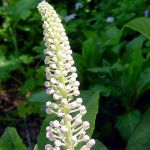| Common Name: |
Indian Poke |
| Botanical Name: |
Phytolacca acinosa |
| Genus: |
Phytolacca |
| Family: |
Phytolaccaceae |
| Native Location: |
Kashmir to SW China |
| Cultivation: |
Rich, moist, well-drained soil in sun or partial shade. |
| Propagation: |
By seed sown at 13-18°C (55-64°F) in early spring. |
| Harvest: |
Roots and fruits are collected in autumn and dried for decoctions, liquid extracts, powder, poultices, and tinctures. |
| Warning: |
All parts, notably leaves and berries, are toxic if eaten. Sap is irritant to skin and eyes. |
| Height: |
90cm-1.5m (3-5ft) |
| Width: |
90cm-1.5m (3-5ft) |
| Hardiness: |
Z8 |
| Parts Used: |
Roots (shang lu) |
| Properties: |
A bitter, pungent, cooling herb that has diuretic and expectorant effects, and controls coughing. It is effective against various bacterial and fungal infections. |
| Medicinal Uses: |
Internally for urinary disorders, nephritis, edema, and abdominal distension. Externally for boils, carbuncles, and sores. |
| Bibliography: |
Encyclopedia of Herbs by Deni Brown Copyright © 1995, 2001 Dorling Kindersley Limited. Pg. 314 |

